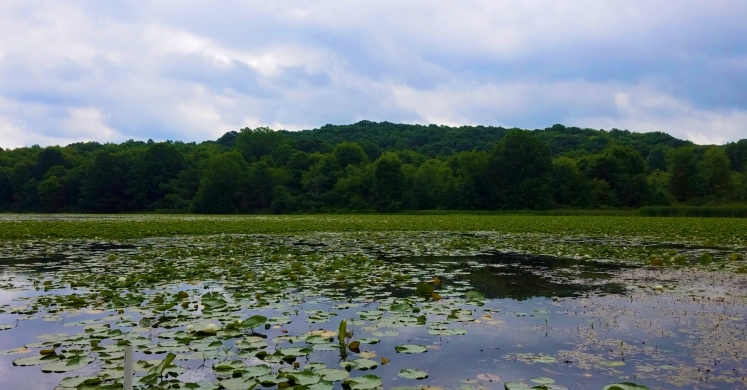Blog

#bioPGH Blog: Wonderful Wetlands
 A resource of Biophilia: Pittsburgh, #bioPGH is a weekly blog and social media series that aims to encourage both children and adults to reconnect with nature and enjoy what each of our distinctive seasons has to offer.
A resource of Biophilia: Pittsburgh, #bioPGH is a weekly blog and social media series that aims to encourage both children and adults to reconnect with nature and enjoy what each of our distinctive seasons has to offer.
I had never seen so many water lilies in one place. Standing on the shoreline, in a break from the stands of cattails, I looked over the expanse of lily pads stretching across the top of the shallow waters. A wetland at its finest, I knew that if I took a few steps forward, I would sink into the water-saturated soil, but I didn’t want to intrude upon the delicate habitat. As the bright sun warmed my shoulders, my ears took in the humming of the pollinators visiting the sweet lilies, the quacks of distant ducks, and the occasional blip-blop sounds of frogs and other creatures as they took refuge under the water from my comparatively giant self. My senses were full of this special habitat—a wetland at Moraine State Park.
Defined as a swampy, water-logged area, wetlands historically were considered pesky, mosquito-and-mud-filled wastes of space. Many wetlands in the past were either drained or filled for various purposes, but in truth, we know now that wetlands are their own breed of ecological magic. Wetlands are among the most biologically productive habitat types in the world, meaning that all of the living things in a wetland (plants, bacteria, algae, animals, etc.) can cycle energy through the ecosystem via photosynthesis and the food web at much higher rates than other habitat types. This explains why on a single visit to a healthy wetland, you are likely to encounter an amazing variety of aquatic plants, amphibians, reptiles, insects, birds, fish, and mammals such as beavers or muskrats.
Besides their incredible ecological productivity level, wetlands are also invaluable to human populations. Many wetlands serve as flood barriers and erosion control by holding excess rain water runoff from storms. Coastal barriers, in particular, buffer the effects of flooding from hurricanes and tropical storms. In fact, after the devastation from Hurricane Katrina, Louisiana developed a plan to restore their coastal wetlands that had been slowly been lost to human activity over the decades leading up to the disaster.
Wetlands also serve as the Earth’s built-in water purification system. Common contaminants in water (heavy metals, excessive sediment, nitrates, phosphates, leaks from human sanitation systems, etc.) are trapped in wetland habitats. From there, they can be either utilized by specialized organisms or held down in the base of wetlands, rather than escaping to waterways that often serve as our recreational, agricultural, or drinking water. Wetlands are so adept at trapping contaminants that many industries recreate wetland systems to purify water for various reasons. A local example of this is Wingfield Pines—a system of settling ponds and wetlands created to remove the iron oxides of abandoned mine drainage from the watershed of Chartiers Creek. Managed by the Allegheny Land Trust, the wetland system of Wingfield Pines can filter anywhere from 1500-2000 gallons of iron oxide-laden water per minute before the water enters Chartiers Creek, and on average, the settling ponds collect 43 tons of iron from the water every year!
The next time you get a chance to visit a wetland, take a moment to just enjoy the peace at the water’s edge. Don’t forget, though, that in spite of the calm exterior, a wetland is a busy, bustling place!
Connecting to the Outdoors Tip: The specific wetland that I visited was at Moraine State Park—off of a little extension of Lake Arthur. It is a beautiful trip and a perfect place to enjoy nature, so make sure you get out there and explore!
Continue the Conversation: Share your nature discoveries with our community by posting to Twitter and Instagram with hashtag #bioPGH, and R.S.V.P. to attend our next Biophilia: Pittsburgh meeting.
Resources
Allegheny Land Trust—Wingfield Pines
WA Department of Ecology—Wetlands
EPA—Functions and Values of Wetlands
Photo Credits: Maria Wheeler-Dubas

